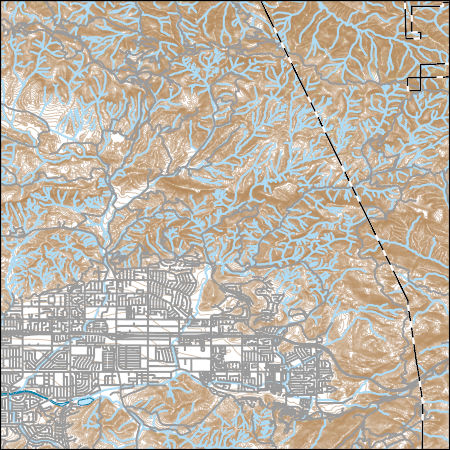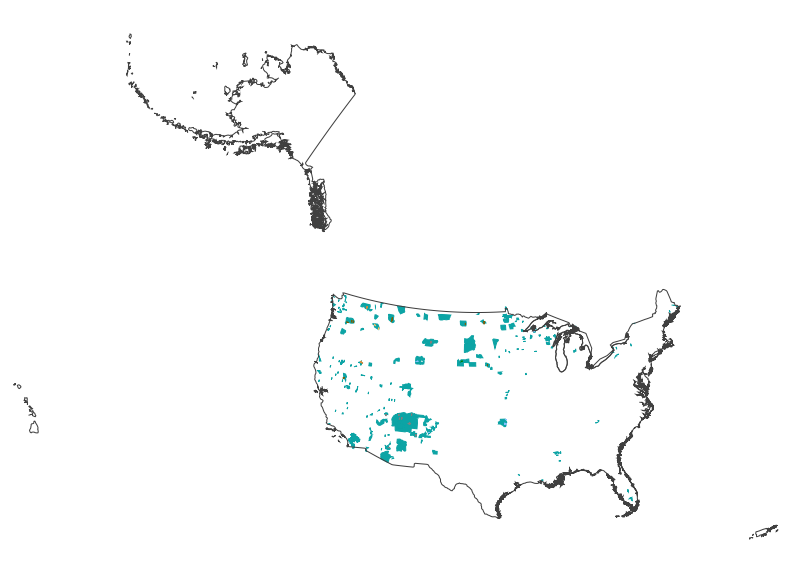Filters: Tags: California (X)
21,320 results (141ms)|
Filters
Date Range
Extensions Types
Contacts
Categories Tag Types
|

Layers of geospatial data include contours, boundaries, land cover, hydrography, roads, transportation, geographic names, structures, and other selected map features.
Here we present the map of potential suitable habitat for Mojave menodora (Menodora spinescens var. mohavensis). The data indicate both how many models predicted each location to be potentially suitable for the species and the average standardized habitat suitability score for each location.Data are presented at a spatial resolution of 10 m pixels, which was required to harmonize the original model inputs. However, maps of suitable habitat should be used at a resolution no smaller than 360 m (i.e., 36 pixels x 36 pixels), which corresponds with the resolution of the coarsest model input. These data are intended to be used only to target future plant surveys in areas where new occurrences are most likely to benefit...
Here we present the map of potential suitable habitat for Beaver Dam breadroot (Pediomelum castoreum). The data indicate both how many models predicted each location to be potentially suitable for the species and the average standardized habitat suitability score for each location.Data are presented at a spatial resolution of 10 m pixels, which was required to harmonize the original model inputs. However, maps of suitable habitat should be used at a resolution no smaller than 360 m (i.e., 36 pixels x 36 pixels), which corresponds with the resolution of the coarsest model input. These data are intended to be used only to target future plant surveys in areas where new occurrences are most likely to benefit future...
Here we present the map of potential suitable habitat for Spanish needle onion (Allium shevockii). The data indicate both how many models predicted each location to be potentially suitable for the species and the average standardized habitat suitability score for each location.Data are presented at a spatial resolution of 10 m pixels, which was required to harmonize the original model inputs. However, maps of suitable habitat should be used at a resolution no smaller than 360 m (i.e., 36 pixels x 36 pixels), which corresponds with the resolution of the coarsest model input. These data are intended to be used only to target future plant surveys in areas where new occurrences are most likely to benefit future habitat...
Here we present the map of potential suitable habitat for Ash Meadows gum-plant (Grindelia fraxinipratensis). The data indicate both how many models predicted each location to be potentially suitable for the species and the average standardized habitat suitability score for each location.Data are presented at a spatial resolution of 10 m pixels, which was required to harmonize the original model inputs. However, maps of suitable habitat should be used at a resolution no smaller than 360 m (i.e., 36 pixels x 36 pixels), which corresponds with the resolution of the coarsest model input. These data are intended to be used only to target future plant surveys in areas where new occurrences are most likely to benefit...
The original time series and cross power data were stored in Binary format on 3.5" disks until further conversion was needed. To convert the time series and cross power data to a format that can be used for modeling, the original binary files were converted to ASCII format using Basic 4.0 code and associated subroutines (see Magnetotelluric_Original-Code_Binary-to-Ascii.txt and Magnetotelluric_Original-Code_Binary-to-Ascii-Subroutines.txt attached to the binary data ScienceBase item). The DaR project used these converted ASCII format files to create the EDI format files included in this data release. The binary data are considered the original data for the magnetotelluric survey, therefore, they are provided with...
This dataset consists of 65 magnetotelluric (MT) stations collected in 2015 near Mountain Pass, California. The U.S. Geological Survey acquired these data to create a regional conductivity model near the Mountain Pass mine. This work is in support of characterizing mineral deposits.
This dataset consists of 65 magnetotelluric (MT) stations collected in 2015 near Mountain Pass, California. The U.S. Geological Survey acquired these data to create a regional conductivity model near the Mountain Pass mine. This work is in support of characterizing mineral deposits.
Five principal components are used to represent the climate variation in an original set of 12 composite climate variables reflecting complex precipitation and temperature gradients. The dataset provides coverage for future climate (defined as the 2040-2070 normal period) under the RCP8.5 emission scenarios. Climate variables were chosen based on their known influence on local adaptation in plants, and include: mean annual temperature, summer maximum temperature, winter minimum temperature, annual temperature range, temperature seasonality (coefficient of variation in monthly average temperatures), mean annual precipitation, winter precipitation, summer precipitation, proportion of summer precipitation, precipitation...
Categories: Data;
Types: Downloadable,
GeoTIFF,
Map Service,
Raster;
Tags: Arizona,
California,
Colorado,
Colorado Plateau,
Great Basin,
Included here are the model, data, and reponse files used to create the 2D electrical resistivity model. Plots of the data and model response are provided as well as one of the model. The data, model, mesh, regularization, and response files are provided in Occam2D format. See https://marineemlab.ucsd.edu/Projects/Occam/2DMT/index.html for details on file format. This data product includes Occam2D data, model, response, and mesh files such that anyone can reproduce the model results. To produce the 2D model the data are rotated to principle strike direction estimated from the phase tensor azimuth, which was nominaly geomagnetic north. The station locations are projected onto a profile line N66E. Bad data points...
These data represent simulated soil temperature and moisture conditions for current climate, and for future climate represented by all available climate models at two time periods during the 21st century. These data were used to: 1) quantify the direction and magnitude of expected changes in several measures of soil temperature and soil moisture, including the key variables used to distinguish the regimes used in the R and R categories; 2) assess how these changes will impact the geographic distribution of soil temperature and moisture regimes; and 3) explore the implications for using R and R categories for estimating future ecosystem resilience and resistance.
An unmanned aerial system (UAS) was used to acquire red/green/blue (RGB) and hyperspectral image data from the American River in California November 5-7, 2018, to support research on remote sensing of rivers, specifically mapping chinook salmon spawning locations (redds) as part of an overall salmon habitat assessment program. The RGB images were acquired uisng a DJI MAtrice 210 equipped with a Zenmuse 4S optical camera. Imagery was collected along several parallel flight lines to ensure full coverage of the study reach. Raw Zenmuse images were georeferenced using real-time kinematic (RTK) global positioning system (GPS) and inertial motion unit (IMU) data recorded onboard the UAS and individual flight strips were...
Categories: Data,
Data Release - In Progress;
Types: Map Service,
OGC WFS Layer,
OGC WMS Layer,
OGC WMS Service;
Tags: American River,
California,
Nimbus Dam,
RGB,
Remote sensing,
This child data release includes field spectra obtained as part of a study focused on mapping chinook salmon spawning locations along the American River near Sacramento, California, via remote sensing; the data were collected November 5-7, 2018. The purpose of this study was to develop and test a spectrally based technique for identifying salmon spawning locations, known as redds, from various types of remotely sensed data. Traditionally, redds have been mapped by eye while walking the bank or from a boat, or by an observer in an aircraft or an interpreter visually examining aerial images. The goal of this proof-of-concept investigation was to assess the potential for more efficient, objective, and automated...
Categories: Data;
Types: Map Service,
OGC WFS Layer,
OGC WMS Layer,
OGC WMS Service;
Tags: American River,
California,
Nimbus Dam,
Remote sensing,
Salmon,
We conducted a radio telemetry study of adult western spadefoots (Spea hammondii) at 2 sites in southern California to characterize their survival, behavior, and movements from breeding through aestivation to inform conservation and management for the species. These data support the following publication: Halstead, B.J., Baumberger, K.L., Backlin, A.R., Kleeman, P.M., Wong, M.N., Gallegos, E.A., Rose, J.P., and Fisher, R.N., 2021. Conservation implications of spatiotemporal variation in the terrestrial ecology of an ephemeral pool-breeding amphibian. The Journal of Wildlife Management.
Categories: Data;
Tags: California,
Orange County,
Southern California,
Spea hammondii,
USGS Science Data Catalog (SDC),
This data release contains luminescence and weather data from eastern Chuckwalla Valley, Riverside County, California. This study investigates sedimentary and geomorphic processes in eastern Chuckwalla Valley, Riverside County, California, a region of arid, basin-and-range terrain where extensive solar-energy development is planned. The objectives were to (1) measure local weather parameters and use them to model aeolian sediment transport potential; (2) identify surface sedimentary characteristics in representative localities; and (3) evaluate longer-term landscape evolution rates and processes by analyzing stratigraphy in combination with luminescence geochronology.

This map layer shows Indian lands of the United States. For the most part, only areas of 320 acres or more are included; some smaller areas deemed to be important or significant are also included. Federally-administered lands within a reservation are included for continuity; these may or may not be considered part of the reservation and are simply described with their feature type and the administrating Federal agency. Some established Indian lands which are larger than 320 acres are not included in this map layer because their boundaries were not available from the owning or administering agency.
These data are a summary of modeled exposure of various lifeline infrastructure linear features and facilities (transportation, water supply and wastewater, oil and gas, electric power, and telecommunications) to potential hazards resulting from the HayWired earthquake scenario, a magnitude 7.0 earthquake occurring on the Hayward Fault on April 18, 2018, with an epicenter in the city of Oakland, CA. Existing hazard data (surface offset, ground shaking (mainshock and aftershocks), landslide, liquefaction, and fire following earthquake) were looked at alone and in combination with each other relative to the lifeline infrastructure linear features and facilities to provide estimates of potential exposure to various...
Types: Map Service,
OGC WFS Layer,
OGC WMS Layer,
OGC WMS Service;
Tags: California,
HayWired,
San Francisco Bay area,
aftershocks,
earthquakes,
Map containing historical census data from 1900 - 2000 throughout the western United States at the county level. Data includes total population, population density, and percent population change by decade for each county. Population data was obtained from the US Census Bureau and joined to 1:2,000,000 scale National Atlas counties shapefile.
Categories: Data;
Types: Downloadable,
Map Service,
OGC WFS Layer,
OGC WMS Layer,
Shapefile;
Tags: Arizona,
California,
Colorado,
Idaho,
Montana,
Our objective is to improve the scientific understanding of the modes, rates, and mechanisms of carbon stabilization and losses in soils from Alaska, California, and other Western states. We focus on the biophysical and microbial mechanisms that drive carbon gains and losses, and to use our data to improve models of soil carbon cycling. This catalog supports research from several projects focused on soil carbon cycling. It encompasses multiple types of datasets including environmental, ecological, biological, isotopic, mineralogical, genomic, flux, and modeled data from water, vegetation, soil, and atmospheric matrices. The catalog will be available online and to the public. Therefore, publication of data through...
The Critical Minerals in Archived Mine Samples Database (CMDB) contains chemistry and geologic information for historic ore and ore-related rock samples from mineral deposits in the United States. In addition, the database contains samples from archetypal deposits from 27 other countries in North America, South America, Asia, Africa and Europe. Samples were obtained from archived ore collections under the U.S. Geological Survey's project titled "Quick Assessment of Rare and Critical Metals in Ore Deposits: A National Assessment" (2008 to 2013) in an effort to begin an assessment of the Nations' previously mined ore deposits for critical minerals. Mineralized and altered rock samples were provided by the Colorado...
Categories: Data;
Types: ArcGIS REST Map Service,
ArcGIS Service Definition,
Downloadable,
Map Service,
OGC WFS Layer,
OGC WMS Layer,
Shapefile;
Tags: Alaska,
Argentina,
Arizona,
Arkansas,
Australia,
|

|